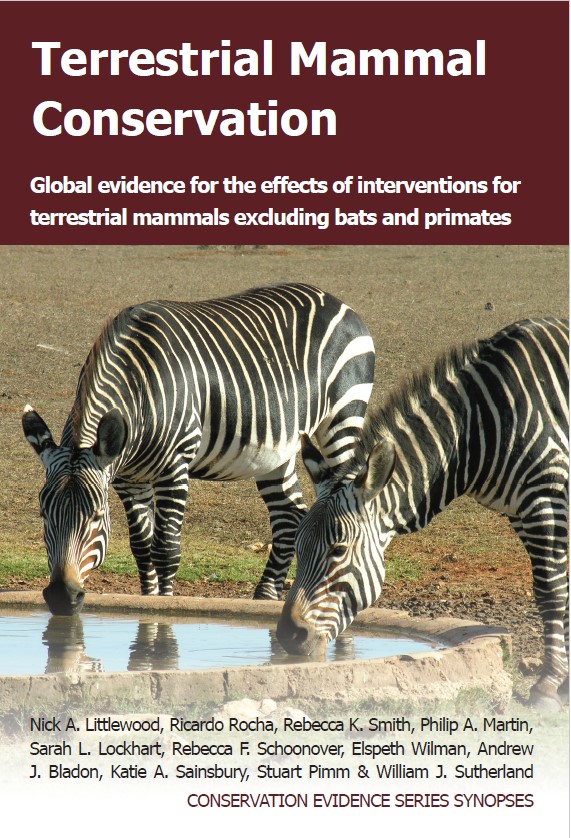Actions to conserve biodiversity
We have summarised evidence from the scientific literature about the effects of actions to conserve wildlife and ecosystems.
Review the evidence from the studies
Not sure what Actions are? Read a brief description.
Search for evidence
e.g. "frogs chytrid"
294 Actions found
Refine
Hide
294 Actions found
Download Actions
| 0 selected |
|
Order results by:
| Action | Effectiveness | Studies | Category | |
|---|---|---|---|---|
|
Remove roadkill regularly to reduce kill rate of predators/scavengers Action Link |
No evidence found (no assessment) | 0 |
|
|
|
Retain/maintain road verges as small mammal habitat Action Link |
No evidence found (no assessment) | 0 |
|
|
|
Use selective trapping methods in hunting activities Action Link |
No evidence found (no assessment) | 0 |
|
|
|
Use alternative de-icers on roads Action Link |
No evidence found (no assessment) | 0 |
|
|
|
Use reflective collars or paint on mammals to reduce collisions with road vehicles Action Link |
No evidence found (no assessment) | 0 |
|
|
|
Use wildlife decoy to reduce vehicle collisions with mammals Action Link |
No evidence found (no assessment) | 0 |
|
|
|
Make introduction of non-native mammals for sporting purposes illegal Action Link |
No evidence found (no assessment) | 0 |
|
|
|
Commercially breed for the mammal production trade Action Link |
No evidence found (no assessment) | 0 |
|
|
|
Promote sustainable alternative livelihoods Action Link |
No evidence found (no assessment) | 0 |
|
|
|
Promote mammal-related ecotourism Action Link |
No evidence found (no assessment) | 0 |
|
|
|
Provide science-based films, radio programmes, or books about mammals to improve behaviour towards mammals and reduce threats Action Link |
No evidence found (no assessment) | 0 |
|
|
|
Use tree tubes/small fences/cages to protect individual trees Action Link |
No evidence found (no assessment) | 0 |
|
|
|
Control firewood collection in remnant native forest and woodland Action Link |
No evidence found (no assessment) | 0 |
|
|
|
Harvest timber outside mammal reproduction period Action Link |
No evidence found (no assessment) | 0 |
|
|
|
Coppice trees Action Link |
No evidence found (no assessment) | 0 |
|
|
|
Install barrier fencing along waterways Action Link |
No evidence found (no assessment) | 0 |
|
|
|
Retain riparian buffer strips during timber harvest Action Link |
No evidence found (no assessment) | 0 |
|
|
|
Establish deviation ponds in fish farms to reduce predation of fish stock by mammals to reduce human-wildlife conflict Action Link |
No evidence found (no assessment) | 0 |
|
|
|
Eliminate highly virulent diseases early in an epidemic by culling all individuals (healthy and infected) in a defined area Action Link |
No evidence found (no assessment) | 0 |
|
Download Actions
| 0 selected |
|

Terrestrial Mammal Conservation - Published 2020
Terrestrial Mammal Conservation
Watch this search
If you are familiar with RSS feeds, please click the button below to retrieve the feed URL:
RSS feed for this searchIf you are unfamiliar with RSS feeds, we would suggest reading this BBC article.
Unfortunately, due to the number of feeds we have available, we cannot provide e-mail updates. However, you could use tools such as Feed My Inbox to do this for you.
What are 'Individual studies' and 'Actions'?
Individual studies
An individual study is a summary of a specific scientific study, usually taken from a scientific journal, but also from other resources such as reports. It tells you the background context, the action(s) taken and their consequences.
If you want more detail please look at the original reference.
Actions
Each action page focuses on a particular action you could take to benefit wildlife or ecosystems.
It contains brief (150-200 word) descriptions of relevant studies (context, action(s) taken and their consequences) and one or more key messages.
Key messages show the extent and main conclusions of the available evidence. Using links within key messages, you can look at the paragraphs describing each study to get more detail. Each paragraph allows you to assess the quality of the evidence and how relevant it is to your situation.
Where we found no evidence, we have been unable to assess whether or not an intervention is effective or has any harmful impacts.





)_2023.JPG)














